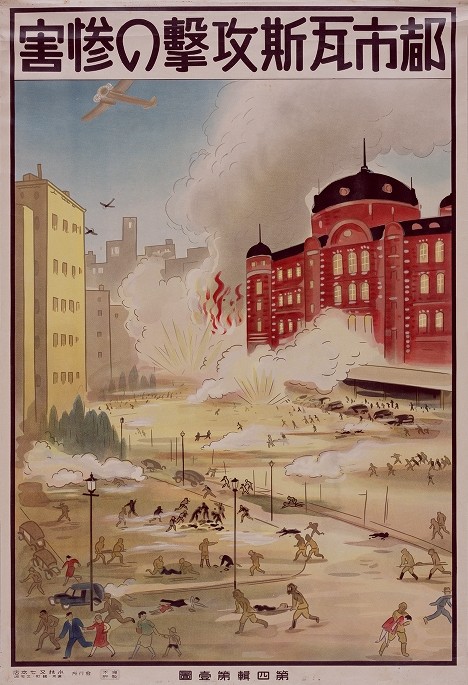
Devastation of Urban Gas Attack
In 1938, the Japanese Red Cross worked with government authorities to create a series of posters to teach the public about the new Anti-Aircraft Defense Law, which was enacted in seeming anticipation of air strikes following the outbreak of the Japan-China War (1937-1945). Among other things, the new law required citizens to take protective measures against gas attacks and prepare for disinfection, evacuation and relief. For the government, one purpose of the posters -- which were created as part of a military exhibition at the Red Cross Museum -- was to instill a pattern of "anti-aircraft defense thought" among the population.
- - - - -
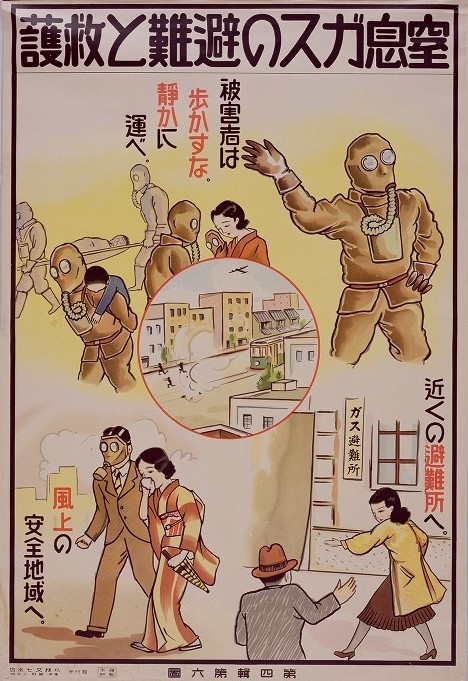
Asphyxiant Gas: Evacuation and Aid
Do not allow victims to walk. Carry them gently.
Head to a nearby shelter.
Move to a safe location upwind.
- - - - -
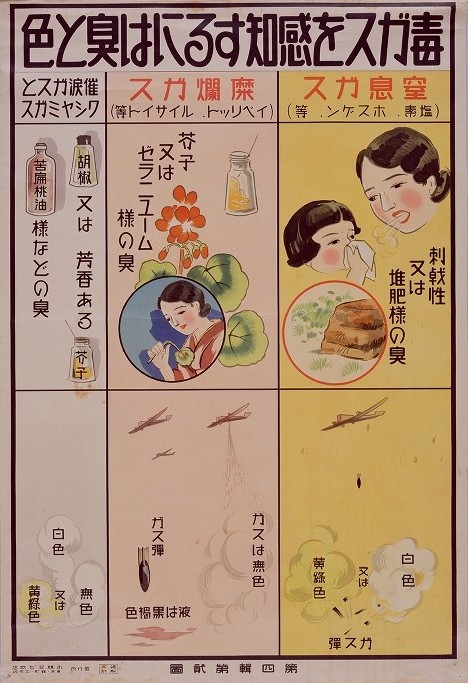
Gas Detection: Smell and Color
- Asphyxiant gas (chlorine, phosgene, etc.): Pungent or hay-like odor. White or yellowish in color.
- Blister gas (yperite/mustard gas, lewisite, etc.): Mustard or geranium-like odor. Colorless in gas form, reddish-brown in liquid form.
- Tear gas and sneezing gas: Odor resembles pepper, spicy mustard or bitter almond oil. White, yellow or colorless.
- - - - -
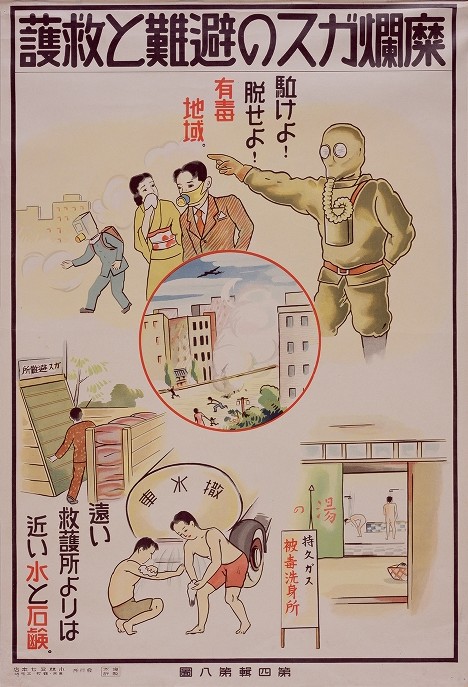
Blister Gas: Evacuation and Aid
Toxic area! Run! Flee!
Better to seek soap and water nearby than to travel to an aid center far away.
- - - - -
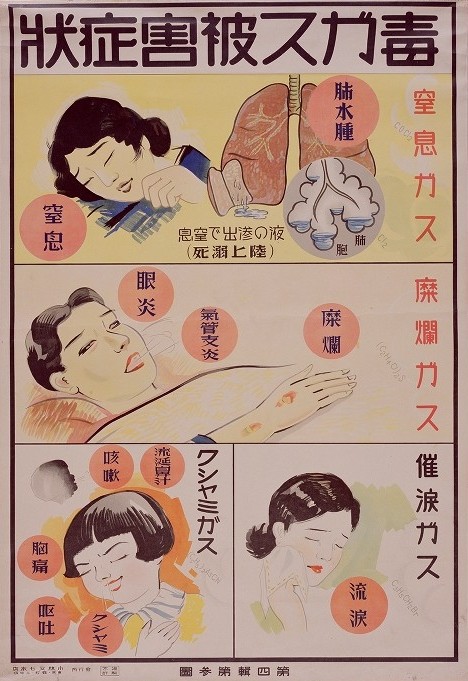
Poison Gas Symptoms
- Asphyxiant gas: Accumulation of fluid in lungs/ Suffocation (dry drowning)
- Blister gas: Blisters/ Respiratory inflammation/ Inflammation of the eyes
- Tear gas: Watery eyes
- Sneezing gas: Salivation and nasal discharge/ Coughing/ Chest pain/ Vomiting/ Sneezing
- - - - -
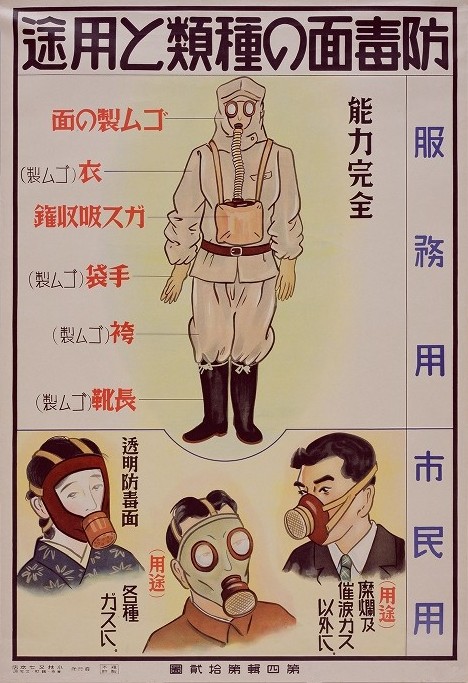
Gas Masks: Type and Purpose
Military use
- Full protection
- Rubber face mask
- Body suit (rubber)
- Filter
- Gloves (rubber)
- Boots (rubber)
Civilian use
- (Right) For any gas except blister gas and tear gas
- (Center) For various types of gas
- (Left) Transparent visor
- - - - -
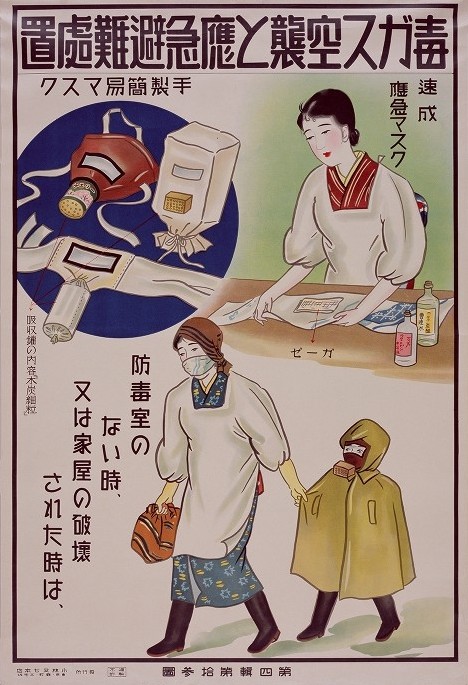
Gas Attack and Emergency Escape
Quick emergency mask
- Gauze
- 2% sodium carbonate/water solution
- 10% urotropin-water solution
Simple homemade masks
- Can contains charcoal particles
Use when no gas shelter is available or when your home has been destroyed.
- - - - -
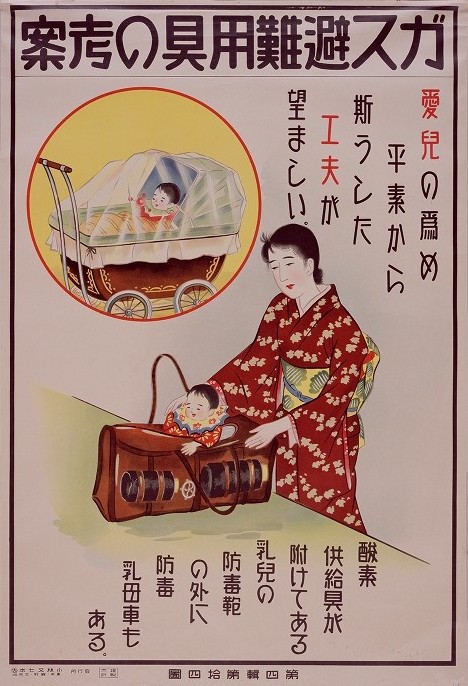
Making Gas Protection Tools
For small children, prepare a gas-tight baby carriage or bag with attached oxygen supply.
Keep this type of protection on hand at all times.
- - - - -
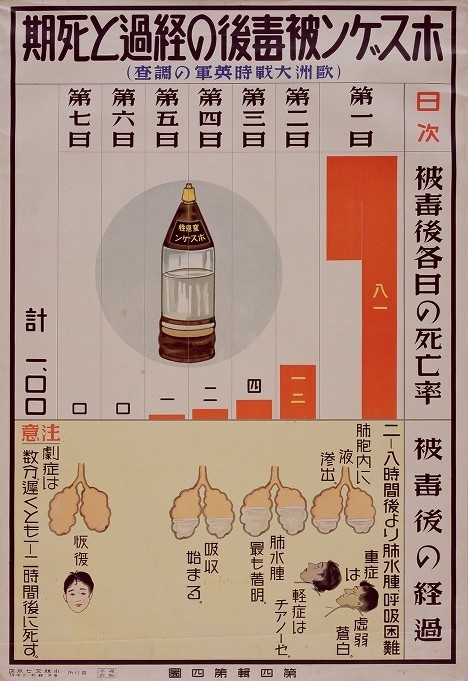
Phosgene Poisoning: Progression of Symptoms and Death
(Based on British Army research during the War in Europe)
Death rate by day:
- Day 1: 81%
- Day 2: 12%
- Day 3: 4%
- Day 4: 2%
- Day 5: 1%
Progression of symptoms
- Fluid begins to accumulate in lungs within 2 to 8 hours, causing difficulty in breathing.
- Fluid seeps into alveoli.
- Victim turns pale in mild cases, ashen white in severe cases.
- Fluid in lungs becomes increasingly evident.
- Absorption begins.
- Recovery.
Caution: Sudden death may occur within minutes or hours.
- - - - -
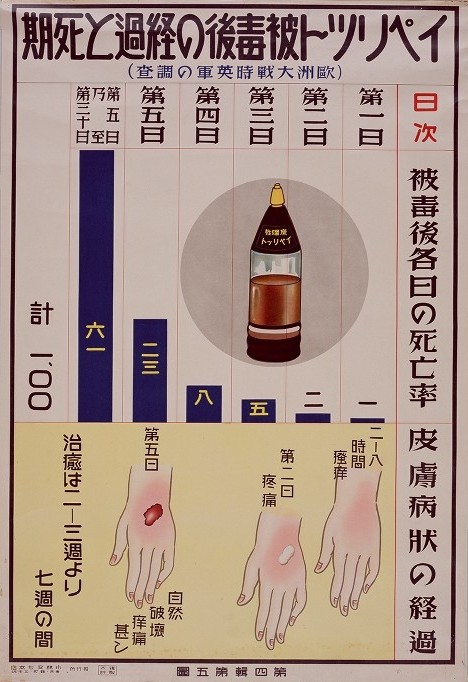
Yperite (Mustard Gas): Progression of Symptoms and Death
(Based on British Army research during the War in Europe)
Death rate by day
- Day 1: 1%
- Day 2: 2%
- Day 3: 5%
- Day 4: 8%
- Day 5: 23%
- Day 6 to 30: 61%
Progression of symptoms
- Initial 2 to 8 hours: Itchiness
- Day 2: Pain
- Day 5: Rupturing of blisters, intense itchiness
Recovery takes 2 to 7 weeks.
- - - - -
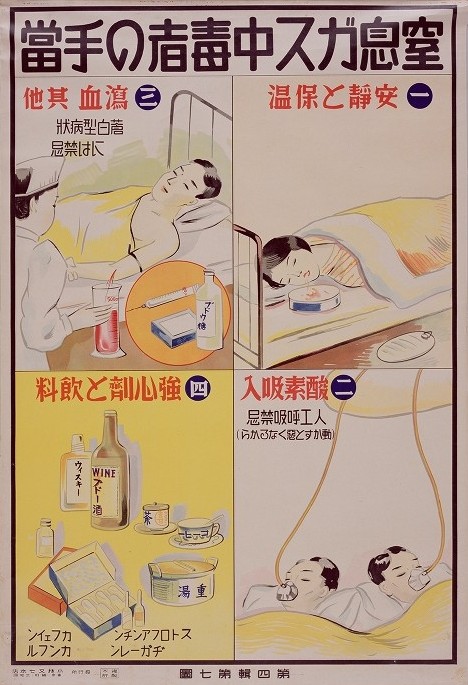
Treatment of Asphyxiant Gas Victims
1. Bed rest and warmth
2. Fresh oxygen supply
- Do not use an artificial respirator (victim may worsen if moved).
3. Blood draw
- Do not perform if the victim is pale.
4. Heart stimulants and beverages
- Strophantin/ Digitoxin/ Caffeine/ Camphor
- - - - -
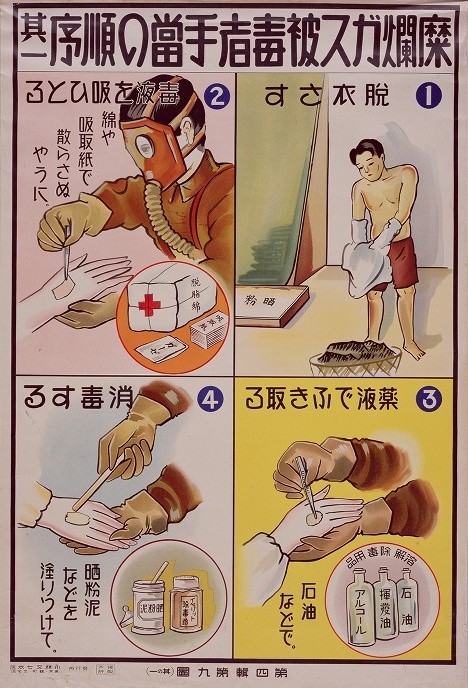
Treatment of Blister Gas Victims (Part 1)
1. Undress.
2. Clean the skin of poisonous substance. (Use cotton or absorbent paper.)
3. Apply solvent (oil, benzene or alcohol).
4. Sterilize. (Apply calcium hypochlorite.)
- - - - -
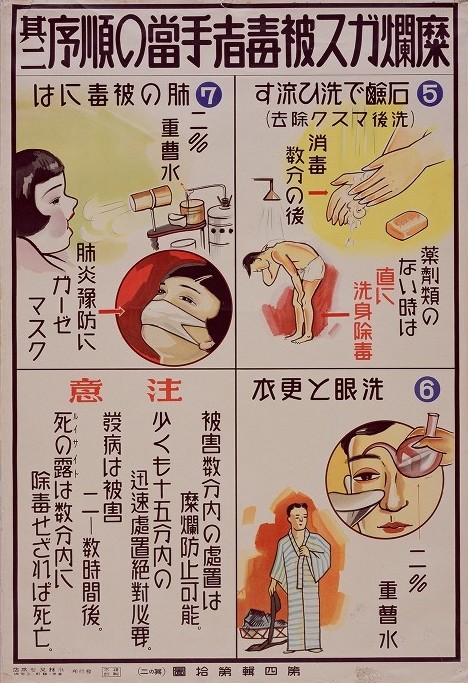
Treatment of Blister Gas Victims (Part 2)
5. Wash thoroughly with soap. (Dispose of mask after washing.) Decontaminate with water if no medicine is available.
6. Wash eyes (2% baking soda/water solution) and put on clean clothes.
7. For poisoned lungs...
2% baking soda/water solution
Gauze mask
Caution
- Immediate action required, at least within 15 minutes of exposure.
- Treatment within the first few minutes of exposure may prevent the development of blisters.
- Symptoms begin to show within a few hours.
- Failure to quickly remove poison from the skin will result in death.
- - - - -
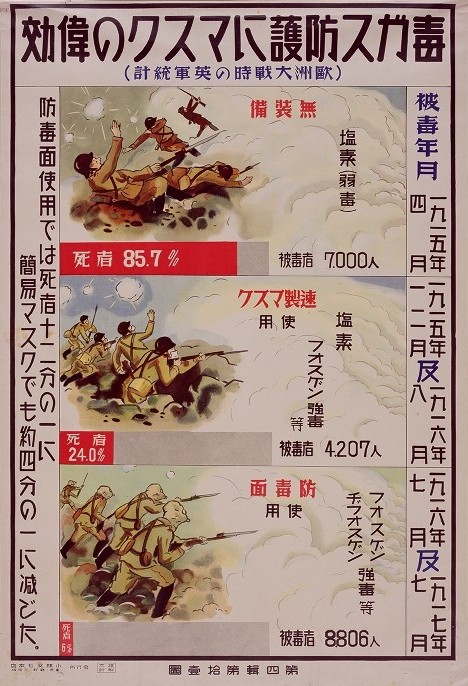
Effectiveness of Gas Masks
(Based on British Army statistics from the War in Europe)
- April 1915/ No masks/ Chlorine gas (weak)/ 7,000 casualties/ 85.7% casualty rate
- December 1915 - August 1916/ Primitive masks (cloth)/ Chlorine, phosgene gas (strong)/ 4,207 casualties/ 24% casualty rate
- July 1916 - July 1917/ Canister gas masks/ Phosgene, diphosgene gas (strong)/ 8,806 casualties/ 6% casualty rate
Canister gas masks reduced the casualty rate by a factor of 12. Primitive masks reduced the casualty rate by a factor of 4.
- - - - -
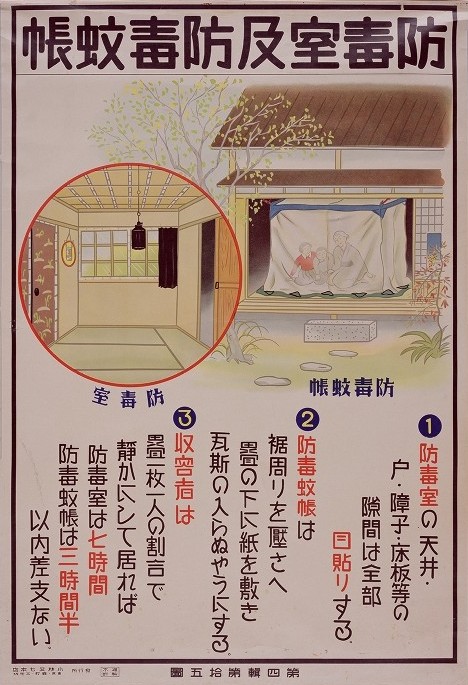
Gas-tight Room and Mosquito Net
1. Seal all gaps in the ceiling, doors and floor to create a gas-tight room.
2. To create a gas-tight tent, keep the bottom hem of the mosquito net pressed to the floor and place a layer of paper over the tatami.
3. Assuming there is one person per tatami mat and you stay calm, you can remain safely in the room for 7 hours and in the tent for 3 hours.
- - - - -
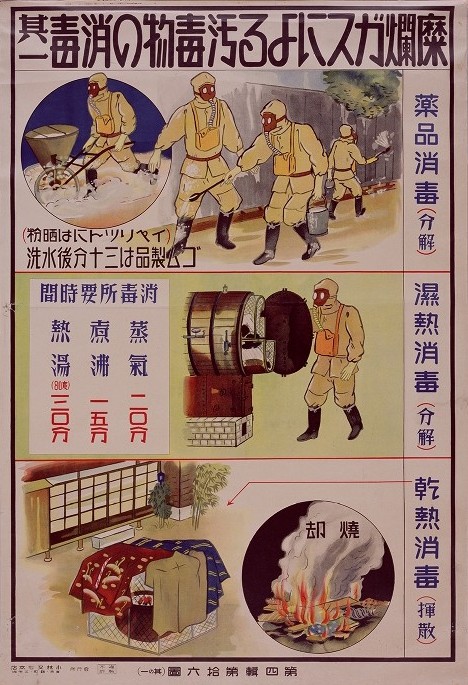
Blister Gas Decontamination (Part 1)
Chemical treatment
- For mustard gas, use calcium hypochlorite.
- Wash rubber products 30 minutes after exposure.
Wet-heat treatment
- Steam: 20 minutes
- Boil: 15 minutes
- Hot water (80 degrees Celsius): 30 minutes
Dry-heat treatment
- Incinerate
- - - - -
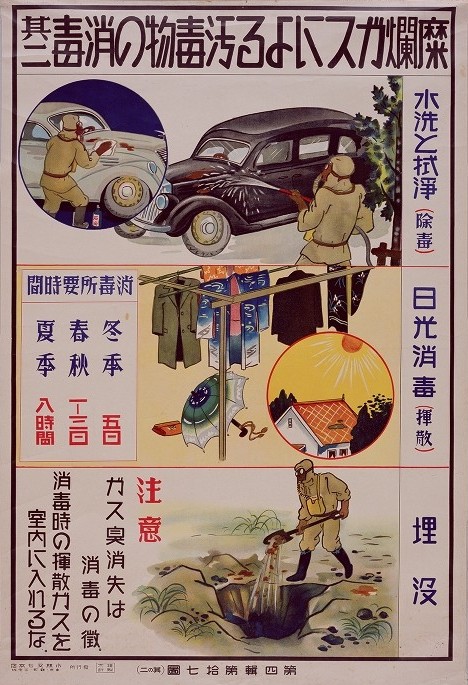
Blister Gas Decontamination (Part 2)
Wash and wipe
Sun-dry
- Winter: 5 days
- Spring/Autumn: 1 to 3 days
- Summer: 8 hours
Burial
- Disappearance of gas odor is a sign of decontamination.
- Do not allow residual gas indoors when decontaminating.
[Link: National Archives of Japan]

Joshua Cook
These posters are amazing. My wife and I plan to watch the documentary "White Light, Black Rain" about the two US nuclear strikes on Japan during World War II. These posters remind me of the terrible experiences of the survivors of these attacks. Thank you for sharing these posters.
[]Timothy
Wow that's crazy. Reminds me of the videos here in the USA during the Cold War. My favorite of these videos talks about possible nuclear attacks in the USA and shows a little kid wearing a full protective (and very heavy) suit, and then riding his bike in it. The whole time you can tell that he can hardly keep the bike up-right since his suit is so heavy.
[]Carlos
Is the red building in the first poster supposed to be Tokyo Station? There seem to be significant structural differences, but the color and prime 'urban' location suggest it could be.
Of course, this is assuming Tokyo Station was the same color in the mid-1930s that it is today.
[]Zentaro
Great posters! This site always comes up with great content like this.
I also wonder what building that is the first poster.
[]freedomwv
If they had only known that poison gas was the last thing they had to be worry about.
[]Daniel Buchmeier
Would love to see these in person. Wish I could get reproductions of these. Anyone have any ideas?
[]